Financial Analysis: Tesla Bond Rating and Default Risk Assessment
VerifiedAdded on 2020/04/15
|6
|1085
|88
Report
AI Summary
This report analyzes Tesla's bond rating following a recent bond issue, examining its impact on the company's financial standing and the associated risks for investors. The analysis delves into the implications of subordinated debt, highlighting how it affects the bond's priority in case of financial distress. The report also assesses the impact of an additional $1 billion in bonds on Tesla's credit rating, predicting a potential decline due to increased debt burden. Furthermore, the report calculates the probability of default (PD) for Tesla over the next five years, providing investors with an understanding of the likelihood of the company fulfilling its bond obligations. The analysis utilizes data from sources such as Bloomberg.com and incorporates insights from academic research to provide a comprehensive financial evaluation of Tesla's bond-related risks and opportunities.
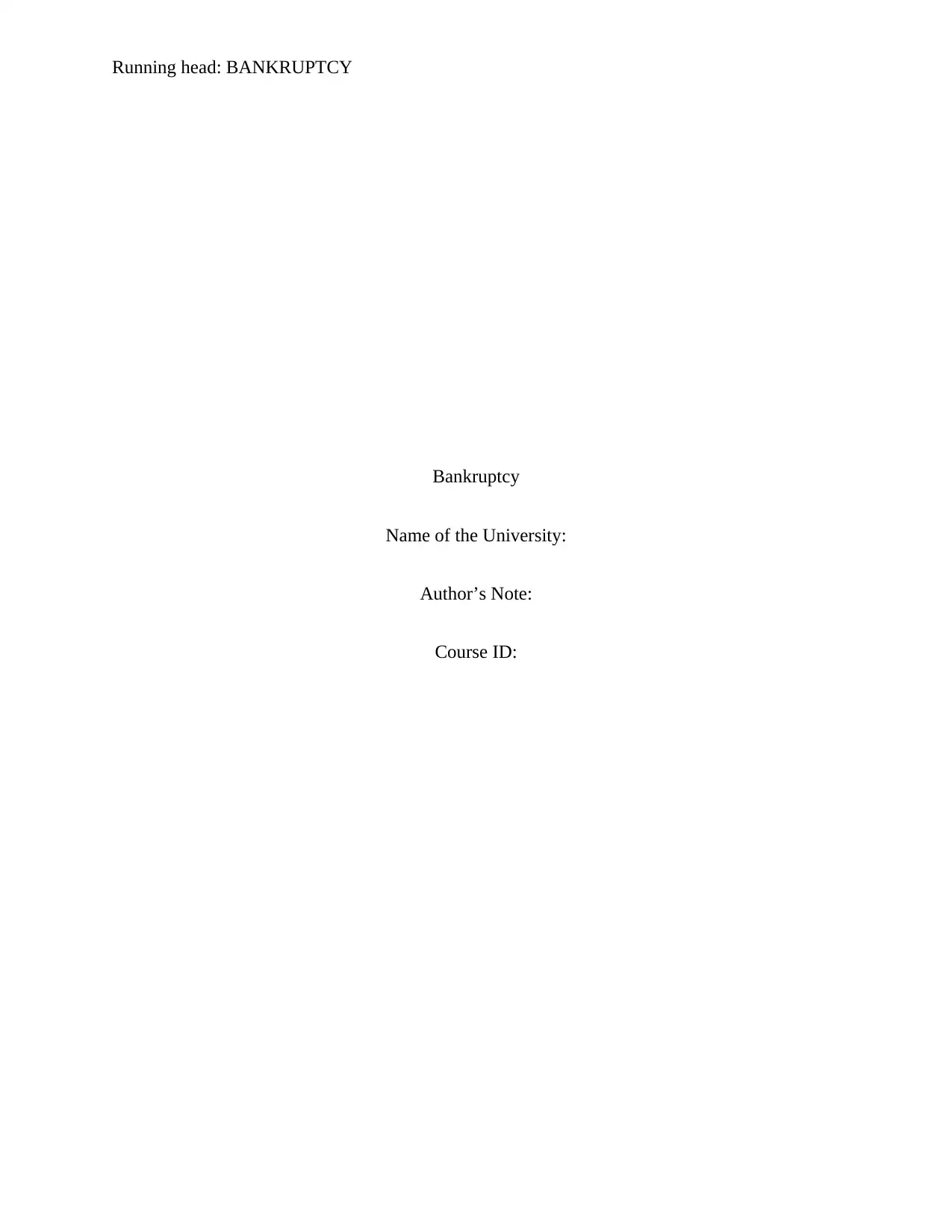
Running head: BANKRUPTCY
Bankruptcy
Name of the University:
Author’s Note:
Course ID:
Bankruptcy
Name of the University:
Author’s Note:
Course ID:
Paraphrase This Document
Need a fresh take? Get an instant paraphrase of this document with our AI Paraphraser
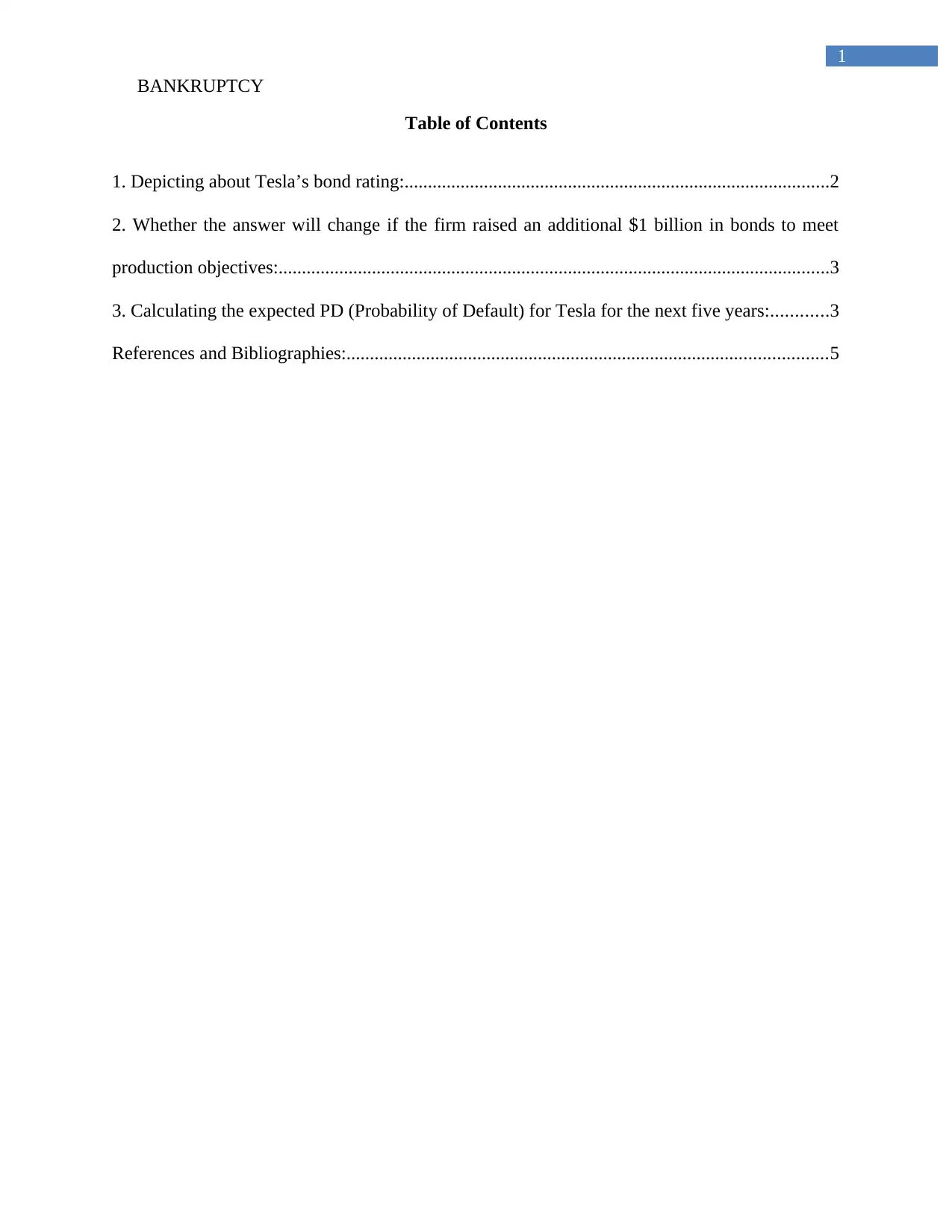
1
BANKRUPTCY
Table of Contents
1. Depicting about Tesla’s bond rating:...........................................................................................2
2. Whether the answer will change if the firm raised an additional $1 billion in bonds to meet
production objectives:......................................................................................................................3
3. Calculating the expected PD (Probability of Default) for Tesla for the next five years:............3
References and Bibliographies:.......................................................................................................5
BANKRUPTCY
Table of Contents
1. Depicting about Tesla’s bond rating:...........................................................................................2
2. Whether the answer will change if the firm raised an additional $1 billion in bonds to meet
production objectives:......................................................................................................................3
3. Calculating the expected PD (Probability of Default) for Tesla for the next five years:............3
References and Bibliographies:.......................................................................................................5
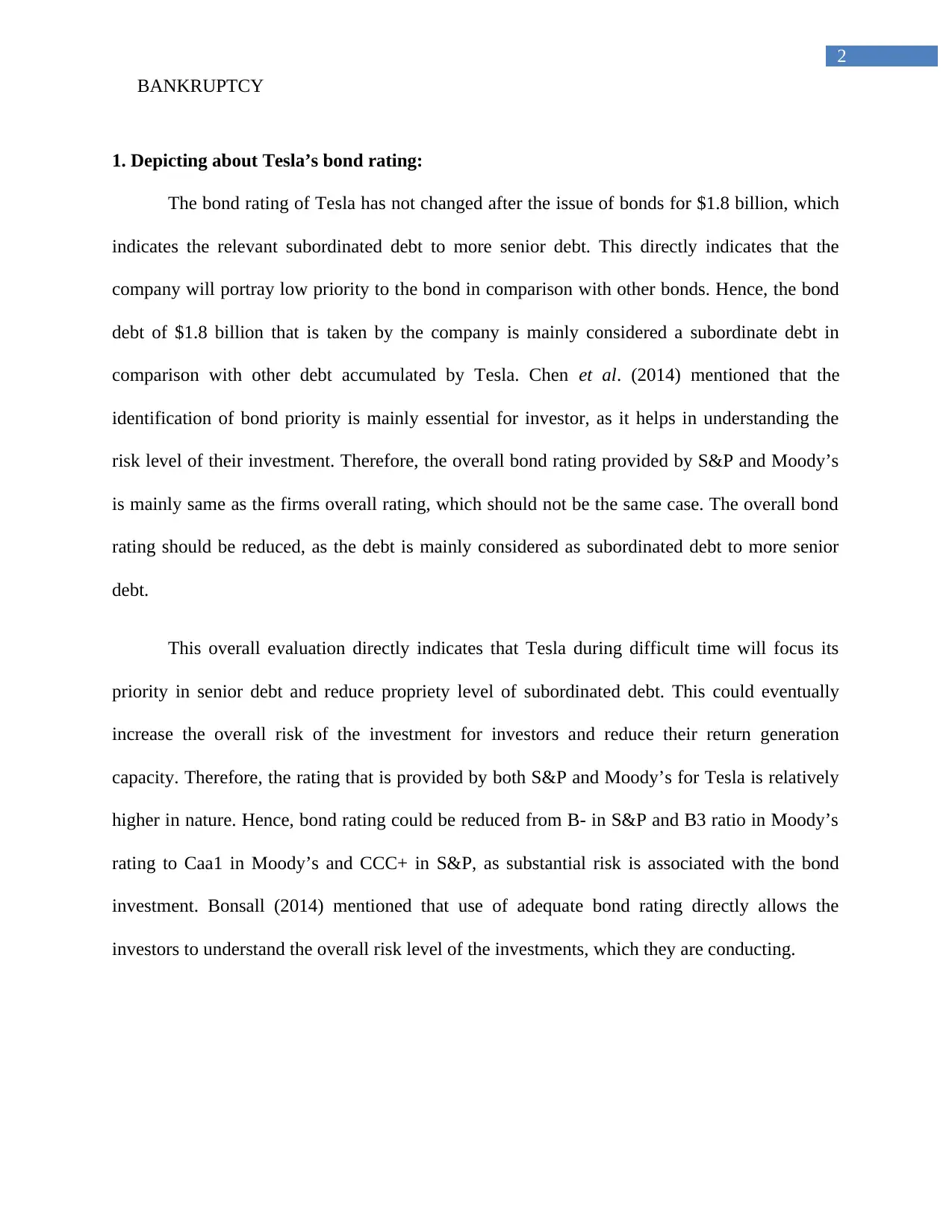
2
BANKRUPTCY
1. Depicting about Tesla’s bond rating:
The bond rating of Tesla has not changed after the issue of bonds for $1.8 billion, which
indicates the relevant subordinated debt to more senior debt. This directly indicates that the
company will portray low priority to the bond in comparison with other bonds. Hence, the bond
debt of $1.8 billion that is taken by the company is mainly considered a subordinate debt in
comparison with other debt accumulated by Tesla. Chen et al. (2014) mentioned that the
identification of bond priority is mainly essential for investor, as it helps in understanding the
risk level of their investment. Therefore, the overall bond rating provided by S&P and Moody’s
is mainly same as the firms overall rating, which should not be the same case. The overall bond
rating should be reduced, as the debt is mainly considered as subordinated debt to more senior
debt.
This overall evaluation directly indicates that Tesla during difficult time will focus its
priority in senior debt and reduce propriety level of subordinated debt. This could eventually
increase the overall risk of the investment for investors and reduce their return generation
capacity. Therefore, the rating that is provided by both S&P and Moody’s for Tesla is relatively
higher in nature. Hence, bond rating could be reduced from B- in S&P and B3 ratio in Moody’s
rating to Caa1 in Moody’s and CCC+ in S&P, as substantial risk is associated with the bond
investment. Bonsall (2014) mentioned that use of adequate bond rating directly allows the
investors to understand the overall risk level of the investments, which they are conducting.
BANKRUPTCY
1. Depicting about Tesla’s bond rating:
The bond rating of Tesla has not changed after the issue of bonds for $1.8 billion, which
indicates the relevant subordinated debt to more senior debt. This directly indicates that the
company will portray low priority to the bond in comparison with other bonds. Hence, the bond
debt of $1.8 billion that is taken by the company is mainly considered a subordinate debt in
comparison with other debt accumulated by Tesla. Chen et al. (2014) mentioned that the
identification of bond priority is mainly essential for investor, as it helps in understanding the
risk level of their investment. Therefore, the overall bond rating provided by S&P and Moody’s
is mainly same as the firms overall rating, which should not be the same case. The overall bond
rating should be reduced, as the debt is mainly considered as subordinated debt to more senior
debt.
This overall evaluation directly indicates that Tesla during difficult time will focus its
priority in senior debt and reduce propriety level of subordinated debt. This could eventually
increase the overall risk of the investment for investors and reduce their return generation
capacity. Therefore, the rating that is provided by both S&P and Moody’s for Tesla is relatively
higher in nature. Hence, bond rating could be reduced from B- in S&P and B3 ratio in Moody’s
rating to Caa1 in Moody’s and CCC+ in S&P, as substantial risk is associated with the bond
investment. Bonsall (2014) mentioned that use of adequate bond rating directly allows the
investors to understand the overall risk level of the investments, which they are conducting.
⊘ This is a preview!⊘
Do you want full access?
Subscribe today to unlock all pages.

Trusted by 1+ million students worldwide
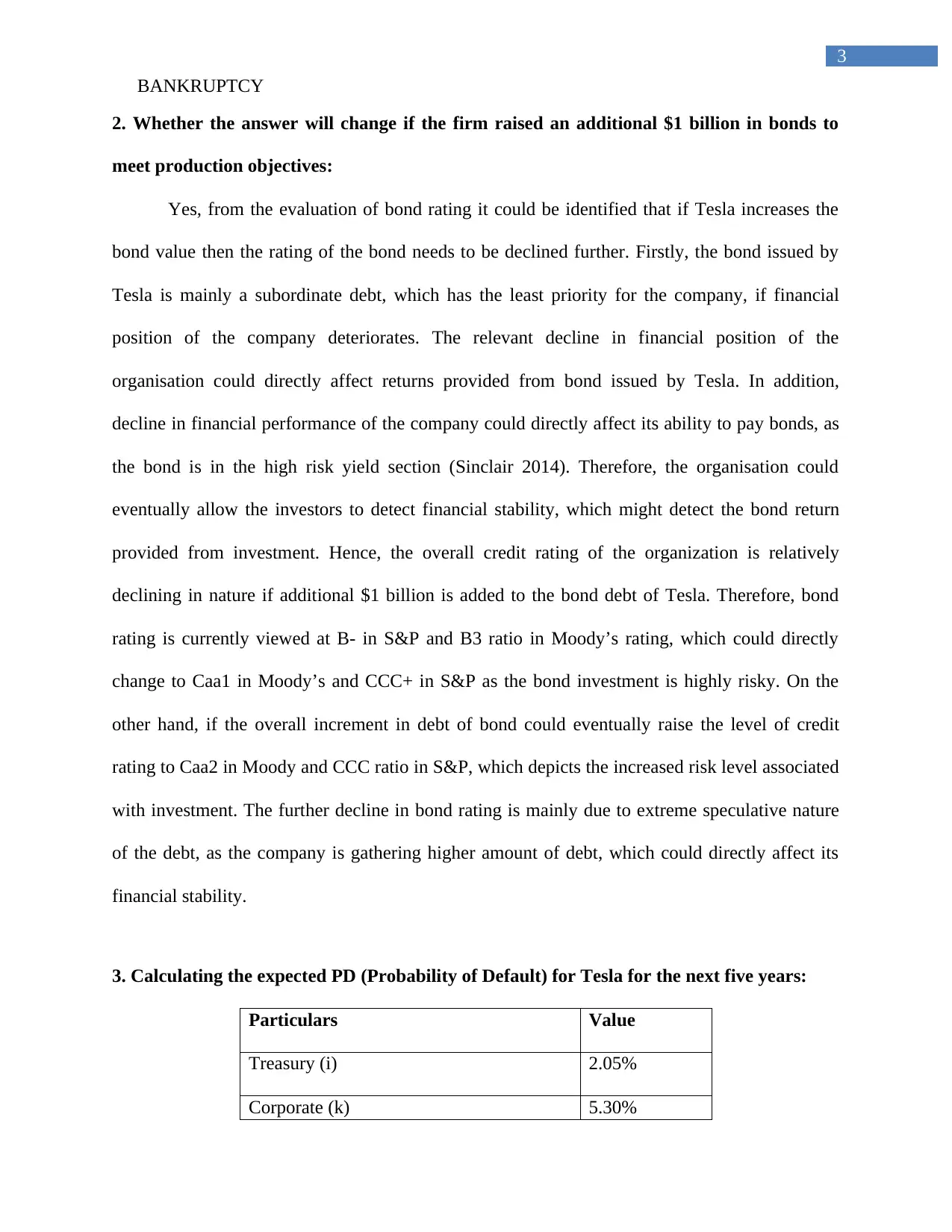
3
BANKRUPTCY
2. Whether the answer will change if the firm raised an additional $1 billion in bonds to
meet production objectives:
Yes, from the evaluation of bond rating it could be identified that if Tesla increases the
bond value then the rating of the bond needs to be declined further. Firstly, the bond issued by
Tesla is mainly a subordinate debt, which has the least priority for the company, if financial
position of the company deteriorates. The relevant decline in financial position of the
organisation could directly affect returns provided from bond issued by Tesla. In addition,
decline in financial performance of the company could directly affect its ability to pay bonds, as
the bond is in the high risk yield section (Sinclair 2014). Therefore, the organisation could
eventually allow the investors to detect financial stability, which might detect the bond return
provided from investment. Hence, the overall credit rating of the organization is relatively
declining in nature if additional $1 billion is added to the bond debt of Tesla. Therefore, bond
rating is currently viewed at B- in S&P and B3 ratio in Moody’s rating, which could directly
change to Caa1 in Moody’s and CCC+ in S&P as the bond investment is highly risky. On the
other hand, if the overall increment in debt of bond could eventually raise the level of credit
rating to Caa2 in Moody and CCC ratio in S&P, which depicts the increased risk level associated
with investment. The further decline in bond rating is mainly due to extreme speculative nature
of the debt, as the company is gathering higher amount of debt, which could directly affect its
financial stability.
3. Calculating the expected PD (Probability of Default) for Tesla for the next five years:
Particulars Value
Treasury (i) 2.05%
Corporate (k) 5.30%
BANKRUPTCY
2. Whether the answer will change if the firm raised an additional $1 billion in bonds to
meet production objectives:
Yes, from the evaluation of bond rating it could be identified that if Tesla increases the
bond value then the rating of the bond needs to be declined further. Firstly, the bond issued by
Tesla is mainly a subordinate debt, which has the least priority for the company, if financial
position of the company deteriorates. The relevant decline in financial position of the
organisation could directly affect returns provided from bond issued by Tesla. In addition,
decline in financial performance of the company could directly affect its ability to pay bonds, as
the bond is in the high risk yield section (Sinclair 2014). Therefore, the organisation could
eventually allow the investors to detect financial stability, which might detect the bond return
provided from investment. Hence, the overall credit rating of the organization is relatively
declining in nature if additional $1 billion is added to the bond debt of Tesla. Therefore, bond
rating is currently viewed at B- in S&P and B3 ratio in Moody’s rating, which could directly
change to Caa1 in Moody’s and CCC+ in S&P as the bond investment is highly risky. On the
other hand, if the overall increment in debt of bond could eventually raise the level of credit
rating to Caa2 in Moody and CCC ratio in S&P, which depicts the increased risk level associated
with investment. The further decline in bond rating is mainly due to extreme speculative nature
of the debt, as the company is gathering higher amount of debt, which could directly affect its
financial stability.
3. Calculating the expected PD (Probability of Default) for Tesla for the next five years:
Particulars Value
Treasury (i) 2.05%
Corporate (k) 5.30%
Paraphrase This Document
Need a fresh take? Get an instant paraphrase of this document with our AI Paraphraser
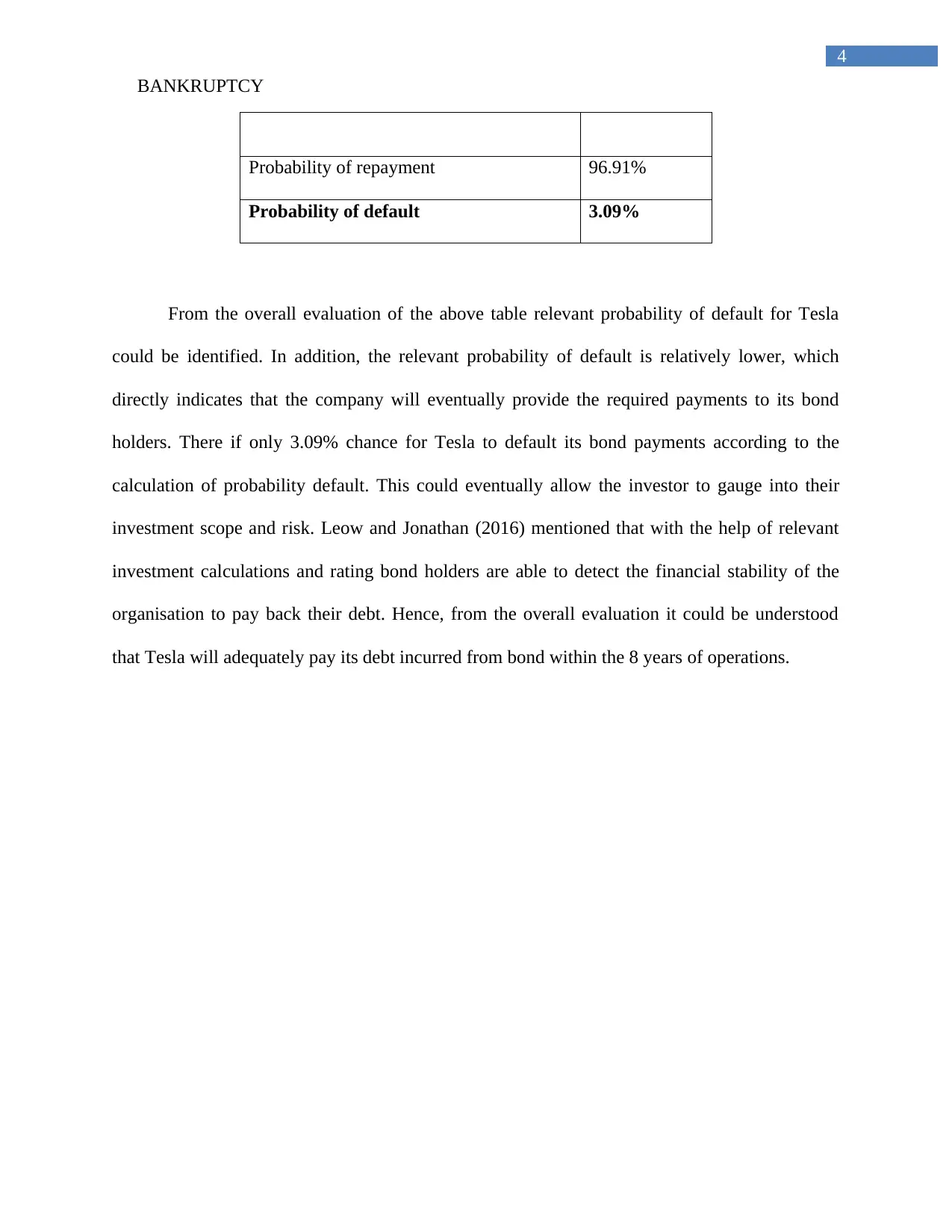
4
BANKRUPTCY
Probability of repayment 96.91%
Probability of default 3.09%
From the overall evaluation of the above table relevant probability of default for Tesla
could be identified. In addition, the relevant probability of default is relatively lower, which
directly indicates that the company will eventually provide the required payments to its bond
holders. There if only 3.09% chance for Tesla to default its bond payments according to the
calculation of probability default. This could eventually allow the investor to gauge into their
investment scope and risk. Leow and Jonathan (2016) mentioned that with the help of relevant
investment calculations and rating bond holders are able to detect the financial stability of the
organisation to pay back their debt. Hence, from the overall evaluation it could be understood
that Tesla will adequately pay its debt incurred from bond within the 8 years of operations.
BANKRUPTCY
Probability of repayment 96.91%
Probability of default 3.09%
From the overall evaluation of the above table relevant probability of default for Tesla
could be identified. In addition, the relevant probability of default is relatively lower, which
directly indicates that the company will eventually provide the required payments to its bond
holders. There if only 3.09% chance for Tesla to default its bond payments according to the
calculation of probability default. This could eventually allow the investor to gauge into their
investment scope and risk. Leow and Jonathan (2016) mentioned that with the help of relevant
investment calculations and rating bond holders are able to detect the financial stability of the
organisation to pay back their debt. Hence, from the overall evaluation it could be understood
that Tesla will adequately pay its debt incurred from bond within the 8 years of operations.
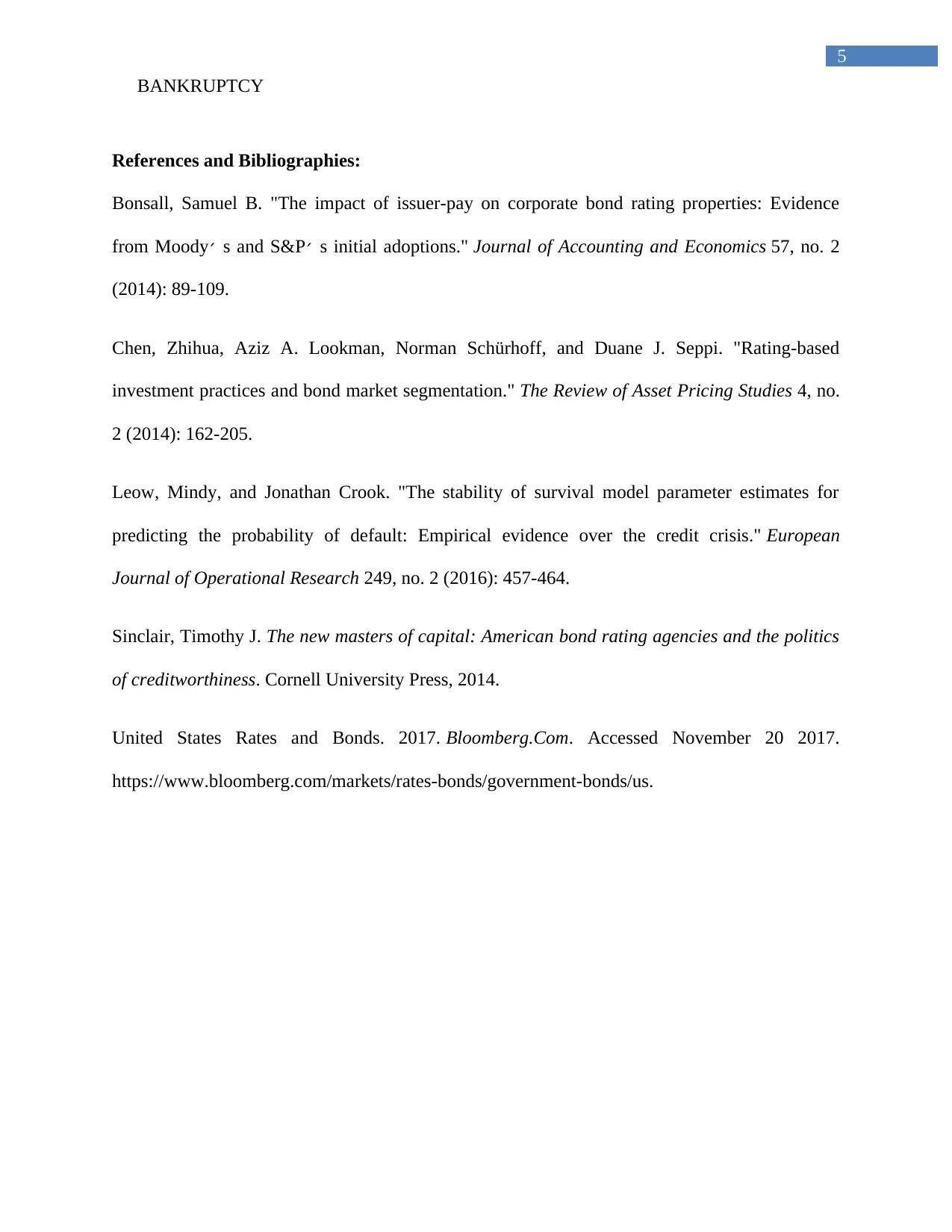
5
BANKRUPTCY
References and Bibliographies:
Bonsall, Samuel B. "The impact of issuer-pay on corporate bond rating properties: Evidence
from Moody׳ s and S&P׳ s initial adoptions." Journal of Accounting and Economics 57, no. 2
(2014): 89-109.
Chen, Zhihua, Aziz A. Lookman, Norman Schürhoff, and Duane J. Seppi. "Rating-based
investment practices and bond market segmentation." The Review of Asset Pricing Studies 4, no.
2 (2014): 162-205.
Leow, Mindy, and Jonathan Crook. "The stability of survival model parameter estimates for
predicting the probability of default: Empirical evidence over the credit crisis." European
Journal of Operational Research 249, no. 2 (2016): 457-464.
Sinclair, Timothy J. The new masters of capital: American bond rating agencies and the politics
of creditworthiness. Cornell University Press, 2014.
United States Rates and Bonds. 2017. Bloomberg.Com. Accessed November 20 2017.
https://www.bloomberg.com/markets/rates-bonds/government-bonds/us.
BANKRUPTCY
References and Bibliographies:
Bonsall, Samuel B. "The impact of issuer-pay on corporate bond rating properties: Evidence
from Moody׳ s and S&P׳ s initial adoptions." Journal of Accounting and Economics 57, no. 2
(2014): 89-109.
Chen, Zhihua, Aziz A. Lookman, Norman Schürhoff, and Duane J. Seppi. "Rating-based
investment practices and bond market segmentation." The Review of Asset Pricing Studies 4, no.
2 (2014): 162-205.
Leow, Mindy, and Jonathan Crook. "The stability of survival model parameter estimates for
predicting the probability of default: Empirical evidence over the credit crisis." European
Journal of Operational Research 249, no. 2 (2016): 457-464.
Sinclair, Timothy J. The new masters of capital: American bond rating agencies and the politics
of creditworthiness. Cornell University Press, 2014.
United States Rates and Bonds. 2017. Bloomberg.Com. Accessed November 20 2017.
https://www.bloomberg.com/markets/rates-bonds/government-bonds/us.
⊘ This is a preview!⊘
Do you want full access?
Subscribe today to unlock all pages.

Trusted by 1+ million students worldwide
1 out of 6
Related Documents
Your All-in-One AI-Powered Toolkit for Academic Success.
+13062052269
info@desklib.com
Available 24*7 on WhatsApp / Email
![[object Object]](/_next/static/media/star-bottom.7253800d.svg)
Unlock your academic potential
Copyright © 2020–2025 A2Z Services. All Rights Reserved. Developed and managed by ZUCOL.




